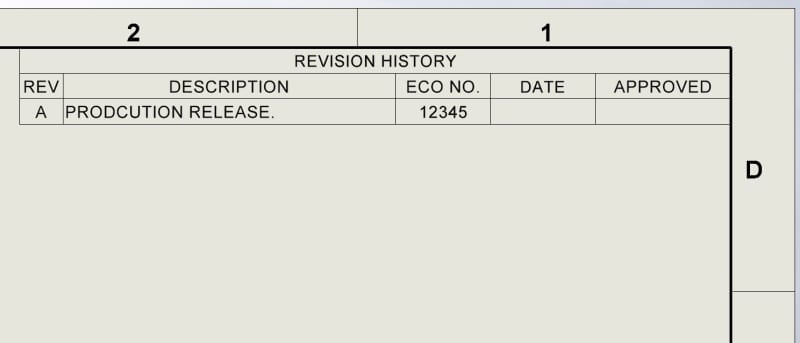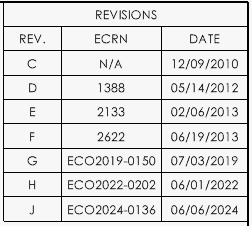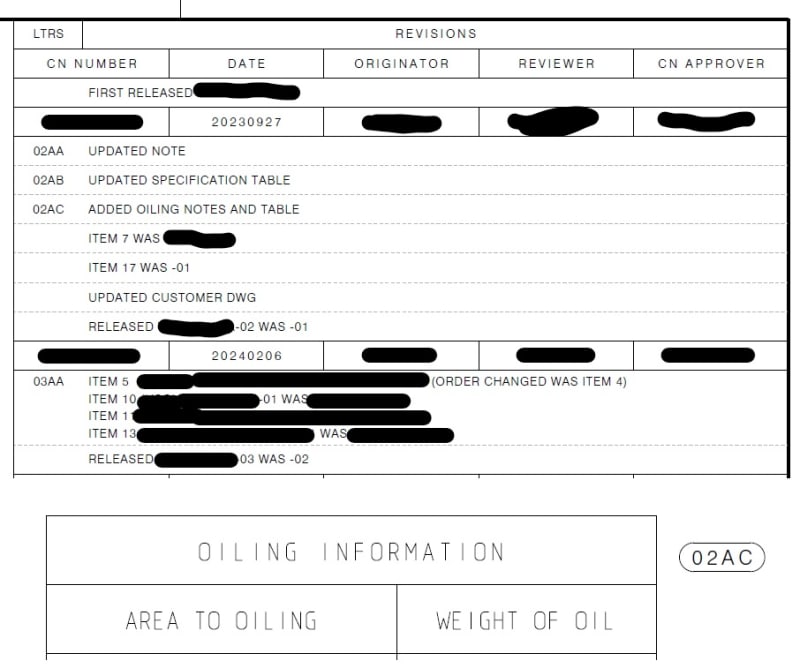What is the industry standard, or standard on recording of what changed on a 2D drawing? For example, if we modify our print, we record every dimension and or note that gets changed on the print. This results in the tedious task of going in and ensuring you get everything recorded correctly.
Navigation
Install the app
How to install the app on iOS
Follow along with the video below to see how to install our site as a web app on your home screen.
Note: This feature may not be available in some browsers.
More options
Style variation
-
Congratulations MintJulep on being selected by the Eng-Tips community for having the most helpful posts in the forums last week. Way to Go!
You are using an out of date browser. It may not display this or other websites correctly.
You should upgrade or use an alternative browser.
You should upgrade or use an alternative browser.
Recording changes on a 2D Print 5
- Thread starter SDETERS
- Start date
- Status
- Not open for further replies.
Create some type of ECO form: the form indicates what has changed. indicates revisions, disposition of change, reason of change, etc.
The drawing has a revision table that tracks revision changes. It can reference the ECO number.
Yes, it gets tedious, but is important to track/document changes.
Chris, CSWP
SolidWorks
ctophers home
The drawing has a revision table that tracks revision changes. It can reference the ECO number.
Yes, it gets tedious, but is important to track/document changes.
Chris, CSWP
SolidWorks
ctophers home
- Thread starter
- #3
We have an ECO form, and ECN process. The revision table do you have an example of what that looks like? I have attached an example of what we usually do on the right hand of our prints. I agree it is important to track and document changes. Just wondering if there was a better way than what we have been doing for years and years. Thanks for the feedback.
-
2
- #4
I see no reason why to clutter a dwg with detailed changes. List them on the ECO form. Ref the ECO number on the rev table.

Chris, CSWP
SolidWorks
ctophers home

Chris, CSWP
SolidWorks
ctophers home
- Thread starter
- #5
DraftingMan
Mechanical
SDETERS,
JHD
This is how we do ours, we track all the changes with drawing markups & an ECR form, currently.
But as you can see we have changed that over the years.
At first there was only a change to the title block revision level, then we change to only a number, then we changed to a year based numbering system within our QMS.

But as you can see we have changed that over the years.
At first there was only a change to the title block revision level, then we change to only a number, then we changed to a year based numbering system within our QMS.

JHD
ctopher said:I see no reason why to clutter a dwg with detailed changes. List them on the ECO form. Ref the ECO number on the rev table
I see no reason in having a different document that contains revision information where a revision block will fit almost all drawings.
This is how we do ours. 3D, 2D is in PLM, info is on the drawing.

Most developed firms use some kind of PLM software for data management. We use Siemens Teamcenter integrated into our company structure and Catia software. Every change notice is requested or approved in TC, and every revision is managed independently.
If you want hassle free work, use a PLM software.
I agree PLM is a way to go. Not every company has it.
If they don't use it, use a form to show changes. I have seen drawings where the entire first sheet is covered in change descriptions. Views are pushed to another sheet.
SDETERS, Do you have some type of PLM?
Chris, CSWP
SolidWorks
ctophers home
If they don't use it, use a form to show changes. I have seen drawings where the entire first sheet is covered in change descriptions. Views are pushed to another sheet.
SDETERS, Do you have some type of PLM?
Chris, CSWP
SolidWorks
ctophers home
pmarc
Mechanical
- Sep 2, 2008
- 3,248
SDETERS said:What is the industry standard, or standard on recording of what changed on a 2D drawing?
ASME Y14.35. The latest revision is 2024 reaffirmed in 2019.
I have had it done different ways at different companies. Currently we just list the ECR in the revision block like this: REVISED PER ECR #####-##.
We have a few canned text lines that we use in the revision block.
Other companies have listed every change with a number for each change, like: C1 WAS 23.2; C2 WAS 12.4.
in both cases, we do use a revision triangle placed next to everything that changed in that revision. We only carry the current revision triangles to keep the clutter down.
"Wildfires are dangerous, hard to control, and economically catastrophic."
Ben Loosli
We have a few canned text lines that we use in the revision block.
Other companies have listed every change with a number for each change, like: C1 WAS 23.2; C2 WAS 12.4.
in both cases, we do use a revision triangle placed next to everything that changed in that revision. We only carry the current revision triangles to keep the clutter down.
"Wildfires are dangerous, hard to control, and economically catastrophic."
Ben Loosli
- Thread starter
- #11
@ctopher Yes we have Siemens NX with Teamcenter, Our ECN process is HCL notes, so we have two different systems. We are a small company with limited Teamcenter licenses.
We usually have everything spelled out as Looslib mentioned with every change.
The reason I am asking is because there are many different tools (Teamcenter visualization, NX track drawing changes for example) that when these tools are used the tools, will show the difference between the two drawings.
Great comments, I do appreciate all of the feedback
Thanks again
Shane
We usually have everything spelled out as Looslib mentioned with every change.
The reason I am asking is because there are many different tools (Teamcenter visualization, NX track drawing changes for example) that when these tools are used the tools, will show the difference between the two drawings.
Great comments, I do appreciate all of the feedback
Thanks again
Shane
ctopher (Mechanical)6 Jun 24 20:29 said:I see no reason why to clutter a dwg with detailed changes...
If I have a fabrication drawing, I want to tell the fabricator explicitly what changes I made. I do not want to release the ECR, as it may contain proprietary information. If you change half the dimensions and notes on a fabrication drawing, it really is time to create a new drawing.
--
JHG
I loved it when we acquired a smaller company and I tried to trace back the changes thru their ECN forms. Most typical revisions said "Changed Dims". I kid you not.
----------------------------------------
The Help for this program was created in Windows Help format, which depends on a feature that isn't included in this version of Windows.
----------------------------------------
The Help for this program was created in Windows Help format, which depends on a feature that isn't included in this version of Windows.
We have old drawings from an acquired company where some have no revisions, others only have revisions, no signatures. ECNs are gone. So, no history.
Very common where engineers design, but are not good at file management.
Chris, CSWP
SolidWorks
ctophers home
Very common where engineers design, but are not good at file management.
Chris, CSWP
SolidWorks
ctophers home
dgallup,
A very long time ago, I set up a set of document management scripts on a UNIX server to manage 2D CAD, PCB files, and other stuff. I set it up so that you had to specify a valid ECR to check out a finalized document. A manager proceeded to generate black ECR so that he could modify stuff, and someone wrote "AS PER ECR-XXXXX" in the revision block.
A lot of people with work to do, have tunnel vision.
--
JHG
A very long time ago, I set up a set of document management scripts on a UNIX server to manage 2D CAD, PCB files, and other stuff. I set it up so that you had to specify a valid ECR to check out a finalized document. A manager proceeded to generate black ECR so that he could modify stuff, and someone wrote "AS PER ECR-XXXXX" in the revision block.
A lot of people with work to do, have tunnel vision.
--
JHG
-
1
- #19
So long as the ECR/ECN trigger others to review and make necessary changes to their parts/assemblies then the process fulfilled its purpose. Revisions happen bc of fit, form, function, cost, and/or quality. I've never needed nor cared to know the reason revisions were created, and production/quality/warranty data tells me what worked/didnt if humans cant. Obviously a complete print database should include every revision but I could care less if old ECRs/ECNs disappeared.
I'm a big advocate for process and documentation but at some point you need to ask whether you're adding value or simply wasting time.
I'm a big advocate for process and documentation but at some point you need to ask whether you're adding value or simply wasting time.
The use of complete on-drawing history is useful when the controlling company has only the master print, keeps no history prints, and wants no other paper to search for.
As they are mainly used I agree that the ECR/ECN process is to get all affected parties to a unified understanding of changes they need to make now.
Sometimes the reason for revision is handy when figuring out why a product changed performance and one can look and see that a specific problem was addressed and maybe a searchable database of those could be used if a similar problem arises elsewhere and the old guy who cane up with the original fix is retired or dead.
Also, I am a proponent of using a Wiki for all product development which would record all the relevant discussions, test reports, proposals, reasons for accepting or rejecting proposed solutions, the entire drawing history from scanned napkins forward. This rather than or in addition to a typical PDM system. If Wikis had an approval system then even the PDM system would not be required.
As they are mainly used I agree that the ECR/ECN process is to get all affected parties to a unified understanding of changes they need to make now.
Sometimes the reason for revision is handy when figuring out why a product changed performance and one can look and see that a specific problem was addressed and maybe a searchable database of those could be used if a similar problem arises elsewhere and the old guy who cane up with the original fix is retired or dead.
Also, I am a proponent of using a Wiki for all product development which would record all the relevant discussions, test reports, proposals, reasons for accepting or rejecting proposed solutions, the entire drawing history from scanned napkins forward. This rather than or in addition to a typical PDM system. If Wikis had an approval system then even the PDM system would not be required.
- Status
- Not open for further replies.
Similar threads
- Question
- Replies
- 35
- Views
- 8K
- Locked
- Question
- Replies
- 4
- Views
- 4K
- Replies
- 6
- Views
- 3K
- Locked
- Question
- Replies
- 9
- Views
- 3K
- Locked
- Question
- Replies
- 6
- Views
- 3K
